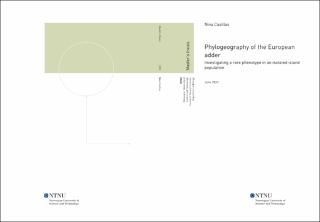| dc.description.abstract | Color polymorphism and the genetic basis driving pattern variation in ectothermic
squamates is greatly under-studied outside of melanocytes. Variation in color and pattern
evolution in wild populations of squamates is a highly informative feature that reflects
details about defense strategies, feeding habits, environmental factors such as temperature,
as well as overall fitness. Vipera berus is the most widely distributed and northernmost
terrestrial snake in the world, yet they show very little variation in morphology across their
range. In this study, we investigated the genetic basis of a rare phenotype not observed to
this degree in the entire range of V. berus using a combination of whole-genome shotgun
sequencing, pairwise FST estimates, genome-scanning and a genome-wide association based
on 3,530,627 SNPs and 154 haplotypes. Seventeen populations of Vipera berus, as well as
five outgroup Vipera species, were sampled within twelve countries across Eurasia to
analyze the population structure of European vipers. Using these methods, we discovered
15 candidate regions, five candidate genes, four potential candidate genes and six SNPs
significantly associated with the striped pattern in the isolated island population of Gossa.
The most notable of these was the discovery of PMEL, a well known key component of
melanosome pigmentation. Additionally, we compared two subspecies of Vipera berus to
investigate why the nominate subspecies had greater success in colonizing their vast range.
This resulted in the discovery of 24 candidate regions, five candidate genes and nine
potential candidate genes that significantly differentiated the two subspecies. Of these,
SVMP was identified as a potential candidate gene, which has been suggested to improve
digestion efficiency of snakes in colder climates. Limitations of this experiment were
primarily due to a lack of access to a thorough genome annotation for Vipera berus, which
prevented the identification of >70% of candidate regions and five significant SNPs using
the genome annotation. Although these genes were not identified using the annotation, they
broaden the possibility of targeting these regions in the future and contribute to our
understanding of genetic variation as well as pigmentation genes among isolated wild
populations of snakes. Our results provide insight into the parallel evolution and genetic
basis of pigmentation between ectothermic squamates using the unbiased approach of
genome scanning, a method that has rarely been used in this context. | |
